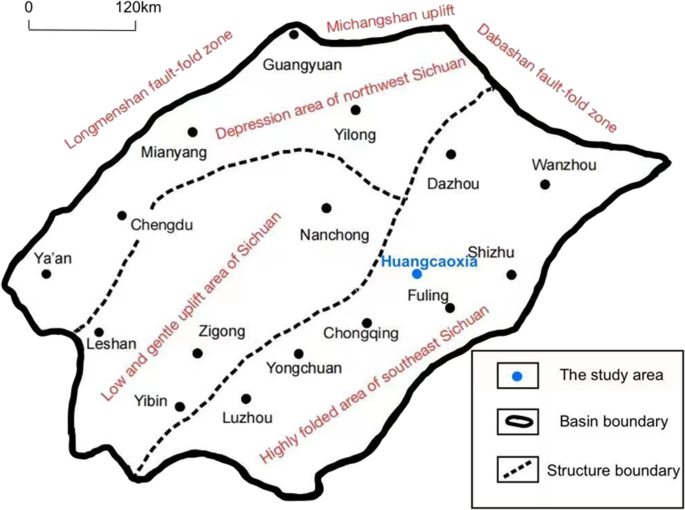Simulation study of hydrogen sulfide removal in underground gas storage converted from the multilayered sour gas field
IF 8.7
1区 工程技术
Q2 ENERGY & FUELS
International Journal of Coal Science & Technology
Pub Date : 2023-11-04
DOI:10.1007/s40789-023-00631-3
引用次数: 0
Abstract
Abstract A simulation study was carried out to investigate the temporal evolution of H 2 S in the Huangcaoxia underground gas storage (UGS), which is converted from a depleted sulfur-containing gas field. Based on the rock and fluid properties of the Huangcaoxia gas field, a multilayered model was built. The upper layer Jia-2 contains a high concentration of H 2 S (27.2 g/m 3 ), and the lower layer Jia-1 contains a low concentration of H 2 S (14.0 mg/m 3 ). There is also a low-permeability interlayer between Jia-1 and Jia-2. The multi-component fluid characterizations for Jia-1 and Jia-2 were implemented separately using the Peng-Robinson equation of state in order to perform the compositional simulation. The H 2 S concentration gradually increased in a single cycle and peaked at the end of the production season. The peak H 2 S concentration in each cycle showed a decreasing trend when the recovery factor (RF) of the gas field was lower than 70%. When the RF was above 70%, the peak H 2 S concentration increased first and then decreased. A higher reservoir RF, a higher maximum working pressure, and a higher working gas ratio will lead to a higher H 2 S removal efficiency. Similar to developing multi-layered petroleum fields, the operation of multilayered gas storage can also be divided into multi-layer commingled operation and independent operation for different layers. When the two layers are combined to build the storage, the sweet gas produced from Jia-1 can spontaneously mix with the sour gas produced from Jia-2 within the wellbore, which can significantly reduce the overall H 2 S concentration in the wellstream. When the working gas volume is set constant, the allocation ratio between the two layers has little effect on the H 2 S removal. After nine cycles, the produced gas’s H 2 S concentration can be lowered to 20 mg/m 3 . Our study recommends combining the Jia-2 and Jia-1 layers to build the Huangcaoxia underground gas storage. This plan can quickly reduce the H 2 S concentration of the produced gas to 20 mg/m 3 , thus meeting the gas export standards as well as the HSE (Health, Safety, and Environment) requirements in the field. This study helps the engineers understand the H 2 S removal for sulfur-containing UGS as well as provides technical guidelines for converting other multilayered sour gas fields into underground storage sites.

多层含硫气田改造地下储气库硫化氢脱除模拟研究
摘要以含硫枯竭气田改造的黄草峡地下储气库(UGS)为研究对象,研究了地下储气库中硫化氢的演化规律。根据黄草峡气田的岩石和流体性质,建立了多层模型。上层Jia-2含有高浓度的h2s (27.2 g/m 3),下层Jia-1含有低浓度的h2s (14.0 mg/m 3)。甲1层和甲2层之间也存在低渗夹层。利用Peng-Robinson状态方程分别对佳1号和佳2号进行多组分流体表征,进行组分模拟。h2s浓度在单周期内逐渐升高,在生产季末达到峰值。当气田采收率(RF)低于70%时,各循环的峰值h2s浓度呈下降趋势。当RF大于70%时,峰值h2s浓度先升高后降低。较高的储层RF、较高的最大工作压力和较高的工作气比将导致较高的h2s去除效率。与开发多层油田类似,多层储气库的作业也可分为多层混合作业和分层独立作业。当两层组合建造储气库时,甲-1产的含硫气可以在井筒内与甲-2产的含硫气自发混合,从而显著降低井流中整体h2s浓度。当工作气量一定时,两层分配比例对h2s去除率影响不大。经过9次循环后,产气的h2s浓度可降至20 mg/ m3。研究建议将甲2层与甲1层结合建设黄草峡地下储气库。该方案可将采出气体的h2s浓度快速降低至20 mg/ m3,从而满足天然气出口标准以及该领域的HSE(健康、安全与环境)要求。该研究有助于工程师了解含硫UGS的h2s去除,并为其他多层含硫气田转化为地下储存场所提供技术指导。
本文章由计算机程序翻译,如有差异,请以英文原文为准。
求助全文
约1分钟内获得全文
求助全文
来源期刊
CiteScore
11.40
自引率
8.40%
发文量
678
审稿时长
12 weeks
期刊介绍:
The International Journal of Coal Science & Technology is a peer-reviewed open access journal that focuses on key topics of coal scientific research and mining development. It serves as a forum for scientists to present research findings and discuss challenging issues in the field.
The journal covers a range of topics including coal geology, geochemistry, geophysics, mineralogy, and petrology. It also covers coal mining theory, technology, and engineering, as well as coal processing, utilization, and conversion. Additionally, the journal explores coal mining environment and reclamation, along with related aspects.
The International Journal of Coal Science & Technology is published with China Coal Society, who also cover the publication costs. This means that authors do not need to pay an article-processing charge.

 求助内容:
求助内容: 应助结果提醒方式:
应助结果提醒方式:


